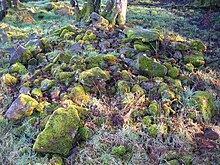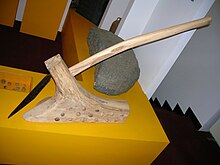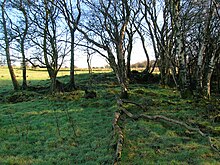91:
surface area for crops to grow and to allow for plants to grow to their full potential; Stones also increase drainage and may therefore deprive plants of moisture. Stones were removed from fields to allow for the efficient use of hand tools, animal powered machines on such fields in the past and for tractors, etc. in more recent times. Some prehistoric clearance cairns may also contain burials. A few clearance cairns may have been additionally created as boundary markers. As ploughing developed and specialised the greater depth tilled and the increased power of mechanised
225:
31:
99:
233:
136:
148:
83:
206:
72:
214:
280:. In general round barrows are larger, more regular, and may contain visible traces of a cist or kerb; stone hut circles have distinct entrances; ring cairns have a hollow centre; and burnt mounds contain a high proportion of fire-crazed stones of rather smaller size than appear in the average clearance cairns within cairnfields.
321:
or the stone walk is a traditional
Scottish athletic event involving the carrying of large stones down the field of competition; the competitors pick up two heavy stones with iron handles, and carry the pair as far as they can. The sport may have grown out of the act of clearing stones from fields to
300:
Due to the age and 'abandoned' state of many clearance cairns, they are often good sites for the growth and survival of lichens, mosses, ferns and other plants; the actual species being dependent on the rock type. Cairns are relatively undisturbed and emulate old walls for the micro-habitats they
309:
In some areas which are now unproductive moorland, aerial photographs show the presence of numerous prehistoric clearance cairns and associated dwellings such as hut-circles. This clear evidence of previous ancient habitation and cultivation shows that the climate worsened until the farmers were
90:
By removing large and moderate size stones from the surface and sub-surface, ploughing can take place with much less potential damage taking place to the plough blade. Stones also prevent the growth of plants where they physically block access to the soil and their removal allows for a greater
110:
Field clearance cairns sometimes survive long after cleared fields have fallen out of use and are often the only surviving evidence of past agricultural activity in areas of woodland, upland areas, etc. The existence of these cairns was once regarded as suggesting pastoral farming. Many now
287:
Clearance cairn material is often heterogeneous, typically consisting of both edged and rounded small stones, sometimes mixed with sand, clay or silt, lifted from the field nearby. Agricultural and clearance cairns are sometimes located on slopes, whilst burial cairns rarely are.
257:
from the peat and do not show typical wood decomposition characteristics due to their preservation within peat bogs. The absence of saw marks indicates felling using axes, providing further information about the age of the wood involved.
252:
and grubbed out tree stumps were sometimes added to the cairns as a result of tree felling and the process of creation of pasture from woodland. Bog-wood stumps and trunks can be thousands of years old, are darker in colour due to the
291:
Clearance cairns constructed using mechanised methods with horse or motor powered assistance may appear superficially similar, however the stones are generally much larger and they are more randomly tipped rather than hand placed.
62:
origins, these cairns may be part of a cairnfield (a collection of closely spaced cairns) where some cairns might be funerary. Clearance cairns are a worldwide phenomenon wherever organised agriculture has been practised.
283:
Natural deposits such as so called 'clitter agglomerates', moraines can also on occasion look rather similar to groups of clearance cairns, but their context, position and regular form usually betrays their true origins.
244:
at various angles to each other, typical of the Bronze Age ploughing methods. These ard-marks indicate that the boulders were obstructing the ploughing process and were in situ for some time before removal.
169:, etc. Many cairns are mainly composed of stones which could have been carried by a single person who would have followed the plough as it turned up small boulders, etc. Most surviving cairns are from the
119:
Cairns built in the middle of enclosures can maximize the effect of daytime radiance, since reradiating absorbed sunlight from the stones raises nighttime field temperatures (very slightly) as in
162:, etc. Where permanent clearance cairns were formed it was predominately on waste land, such as steep slopes, edges of woodland, field corners, and around earth-fast boulders.
261:
Some clearance cairns are linear in form. Many of the smaller cairns were probably created by family groups, whilst larger ones would have required organised labour.
355:
425:
516:
240:
Cairns may be discrete, in large groups (cairnfields) or as linear formations—linear cairns. Many stones in clearance cairns show plough-marks or
482:
676:
598:
401:
264:
Cairnfields have on occasions been confused with various other classes of monuments, such as round barrow cemeteries and groups of
111:
consider them the result of arable or mixed agricultural exploitation enabling ploughing or hand tillage to work more efficiently.
456:
629:
158:
Many clearance stones were used in the construction of defensive structures, houses, farm buildings, walls, drainage ditches,
612:
363:
550:
127:) it may have been deliberately intended, though there is no direct evidence that cairns were built for this purpose.
723:
713:
417:
733:
718:
637:
587:
The Burial Cairns and the
Landscape in the Archipelago of Åboland, SW Finland, in the Bronze Age and the Iron Age
728:
490:
524:
528:
218:
140:
35:
174:
165:
The amount of stone which needed to be cleared from a field depended upon geology, glacial deposits,
494:
95:
resulted in more and larger stones being brought to the surface and these too had to be removed.
672:
668:
604:
594:
397:
558:
393:
224:
166:
30:
98:
232:
135:
707:
448:
318:
186:
182:
120:
103:
641:
331:
265:
241:
159:
76:
585:
173:
but some are considerably older, because field clearance has been practised since
277:
147:
82:
51:
50:
which have been removed from arable land or pasture to allow for more effective
696:
562:
336:
273:
269:
170:
59:
47:
608:
205:
178:
123:. Since this effect would encourage crop growth (and potentially reduce the
92:
71:
213:
17:
249:
151:
190:
254:
194:
231:
223:
212:
204:
146:
134:
124:
97:
81:
70:
55:
29:
476:
474:
424:. England, United Kingdom: Warwickshire County Council. 2009.
139:
A mound associated with a bog-wood and a clearance cairn at
236:
A recent clearance cairn devoid of lichen and moss growth
483:"Introduction to the Archaeology of North Pembrokeshire"
209:
Ard or plough-marks on a boulder in a clearance cairn
593:. Oulu, Finland: Oulu University Press. p. 79.
228:
A clearance cairn formed using mechanised extraction
27:Mound of stones cleared from an agricultural field
217:Ard-marks on a boulder in a clearance cairn at
106:where the stone acts as a slow release radiator
46:is an irregular and unstructured collection of
8:
665:The Landscape of Scotland: A Hidden History
383:
381:
54:and collected into a usually low mound or
698:Commentary and video on Clearance Cairns.
388:Feldman, Louis H.; Hata, Gohei (1989).
347:
584:Tapani, Tuovinen (24 November 2002).
459:from the original on 27 December 2008
7:
618:from the original on 8 August 2017.
86:A reconstructed mould board plough.
481:Pearson, Alastair (24 July 2001).
154:associated with a clearance cairn.
25:
428:from the original on 21 July 2011
322:create pastures and arable land.
663:Wickham-Jones, Caroline (2001).
390:Josephus, the Bible, and History
310:forced to move to lower ground.
34:A typical clearance cairn from
422:timetrail.warwickshire.gov.uk/
1:
175:the beginnings of agriculture
453:www.legendarydartmoor.co.uk/
523:. England, United Kingdom:
517:"Ard-marks at Cladh Hallan"
489:. England, United Kingdom:
360:English Heritage Dictionary
750:
551:"Cairnfields Definition"
491:University of Portsmouth
449:"The Cairns of Dartmoor"
525:University of Sheffield
392:. Leiden, Netherlands:
667:. Berkshire, England:
638:Rhön Biosphere Reserve
237:
229:
221:
210:
155:
144:
107:
87:
79:
39:
447:Sandles, Tim (2007).
248:Other items such as
235:
227:
219:Eglinton Country Park
216:
208:
150:
141:Eglinton Country Park
138:
101:
85:
74:
36:Eglinton Country Park
33:
630:"Plants of the Rhön"
487:www.envf.port.ac.uk/
366:on 12 September 2007
67:Purpose of clearance
671:. pp. 48–50.
238:
230:
222:
211:
156:
145:
108:
88:
80:
40:
724:Landscape history
714:Agricultural land
678:978-0-7524-1484-3
669:Tempus Publishing
555:www.eng-h.gov.uk/
418:"Clearance Cairn"
305:Landscape history
16:(Redirected from
741:
734:Glacial erratics
719:Artificial hills
683:
682:
660:
654:
653:
651:
649:
640:. Archived from
626:
620:
619:
617:
592:
581:
575:
574:
572:
570:
561:. Archived from
559:English Heritage
547:
541:
540:
538:
536:
527:. Archived from
513:
507:
506:
504:
502:
493:. Archived from
478:
469:
468:
466:
464:
444:
438:
437:
435:
433:
414:
408:
407:
394:Brill Publishers
385:
376:
375:
373:
371:
362:. Archived from
352:
181:(such as at the
167:glacial erratics
21:
749:
748:
744:
743:
742:
740:
739:
738:
729:Stone buildings
704:
703:
691:
686:
679:
662:
661:
657:
647:
645:
644:on 4 March 2012
634:www.brrhoen.de/
628:
627:
623:
615:
601:
590:
583:
582:
578:
568:
566:
549:
548:
544:
534:
532:
531:on 5 March 2016
521:www.shef.ac.uk/
515:
514:
510:
500:
498:
480:
479:
472:
462:
460:
446:
445:
441:
431:
429:
416:
415:
411:
404:
387:
386:
379:
369:
367:
354:
353:
349:
345:
328:
316:
307:
298:
296:Natural history
203:
201:Characteristics
133:
117:
75:Single-handled
69:
44:clearance cairn
28:
23:
22:
15:
12:
11:
5:
747:
745:
737:
736:
731:
726:
721:
716:
706:
705:
702:
701:
700:
699:
690:
689:External links
687:
685:
684:
677:
655:
621:
599:
576:
565:on 5 June 2011
542:
508:
470:
439:
409:
402:
396:. p. ??.
377:
346:
344:
341:
340:
339:
334:
327:
324:
315:
314:Stone carrying
312:
306:
303:
297:
294:
202:
199:
160:road metalling
132:
129:
121:walled gardens
116:
115:Heat Radiation
113:
68:
65:
58:. Commonly of
26:
24:
14:
13:
10:
9:
6:
4:
3:
2:
746:
735:
732:
730:
727:
725:
722:
720:
717:
715:
712:
711:
709:
697:
695:
694:
693:
692:
688:
680:
674:
670:
666:
659:
656:
643:
639:
635:
631:
625:
622:
614:
610:
606:
602:
600:951-42-6801-6
596:
589:
588:
580:
577:
564:
560:
556:
552:
546:
543:
530:
526:
522:
518:
512:
509:
497:on 8 May 2009
496:
492:
488:
484:
477:
475:
471:
458:
454:
450:
443:
440:
427:
423:
419:
413:
410:
405:
403:90-04-08931-4
399:
395:
391:
384:
382:
378:
365:
361:
357:
351:
348:
342:
338:
335:
333:
330:
329:
325:
323:
320:
313:
311:
304:
302:
295:
293:
289:
285:
281:
279:
275:
271:
267:
266:round barrows
262:
259:
256:
251:
246:
243:
234:
226:
220:
215:
207:
200:
198:
196:
192:
188:
187:Vestre Slidre
184:
183:Gardberg site
180:
176:
172:
168:
163:
161:
153:
149:
142:
137:
130:
128:
126:
125:risk of frost
122:
114:
112:
105:
104:walled garden
100:
96:
94:
84:
78:
73:
66:
64:
61:
57:
53:
49:
45:
37:
32:
19:
664:
658:
646:. Retrieved
642:the original
633:
624:
586:
579:
567:. Retrieved
563:the original
554:
545:
533:. Retrieved
529:the original
520:
511:
499:. Retrieved
495:the original
486:
461:. Retrieved
452:
442:
430:. Retrieved
421:
412:
389:
368:. Retrieved
364:the original
359:
356:"CAIRNFIELD"
350:
332:Stone picker
317:
308:
299:
290:
286:
282:
278:burnt mounds
263:
260:
247:
239:
164:
157:
118:
109:
89:
43:
41:
636:. Germany:
319:Stone carry
274:ring cairns
270:hut circles
52:agriculture
48:fieldstones
38:in Scotland
708:Categories
648:5 February
569:1 February
535:2 February
463:1 February
432:1 February
370:1 February
343:References
337:Fieldstone
171:Bronze Age
102:A typical
60:Bronze Age
18:Cairnfield
609:0355-3205
301:produce.
242:ard-marks
179:Stone Age
93:ploughing
613:Archived
457:Archived
426:Archived
326:See also
268:, stone
250:bog-wood
152:Bog-wood
131:Creation
501:8 March
255:tannins
191:Oppland
177:in the
675:
607:
597:
400:
195:Norway
616:(PDF)
591:(PDF)
276:, or
56:cairn
673:ISBN
650:2009
605:ISSN
595:ISBN
571:2009
537:2009
503:2023
465:2009
434:2009
398:ISBN
372:2009
197:).
185:in
77:ard
710::
632:.
611:.
603:.
557:.
553:.
519:.
485:.
473:^
455:.
451:.
420:.
380:^
358:.
272:,
193:,
189:,
42:A
681:.
652:.
573:.
539:.
505:.
467:.
436:.
406:.
374:.
143:.
20:)
Text is available under the Creative Commons Attribution-ShareAlike License. Additional terms may apply.







